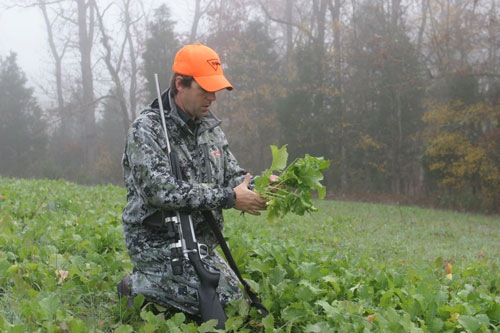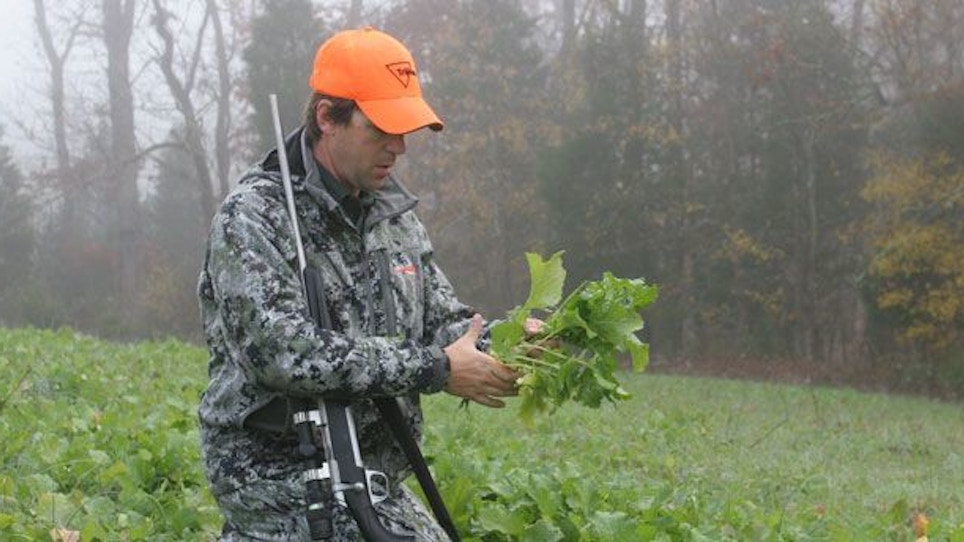As mentioned in Part I, does need to be included in any management plan, and that includes harvesting them. While older bucks won’t always walk into a food plot during legal shooting hours, there almost always will be a few antlerless deer that make that mistake, making a cool-season plot the perfect way to help manage your herd.
 Although many warm-season plants are still growing in the early fall, it’s critical to have at least one new plant available when the summer plants — most of which are annuals — are no longer palatable. One of the best all-purpose, cool-season plots is white clover. It comes in a number of varieties, but they all have one thing in common — deer love them, especially when the plant is in the active-growth stage. Although seed sold at the local farmer’s supply store might produce a healthy stand of clover, it’s not necessarily the best choice for hunters, says Adams.
Although many warm-season plants are still growing in the early fall, it’s critical to have at least one new plant available when the summer plants — most of which are annuals — are no longer palatable. One of the best all-purpose, cool-season plots is white clover. It comes in a number of varieties, but they all have one thing in common — deer love them, especially when the plant is in the active-growth stage. Although seed sold at the local farmer’s supply store might produce a healthy stand of clover, it’s not necessarily the best choice for hunters, says Adams.
“The clover varieties sold by Whitetail Institute, BioLogic and others are undoubtedly better for deer because they were designed specifically for deer,” he says. “The stuff you buy at the farmer’s supply is probably engineered for cattle.”
Clover grows in a variety of climates and will thrive in the both the North and the South. Perennials like white and red clover will last two, three, even four years in some regions. It takes a minimum amount of maintenance, but like any food-plot plant, clover is prone to aggressive weed infestation and requires the proper pH level and soil nutrients. It’s an excellent plant for bowhunters because it’s highly palatable during the cooler period of late September and October. Southern deer will eat it all winter.
Alfalfa is a favorite cool-season deer food as well, but it’s expensive and difficult to grow. Adams says alfalfa varieties sold as deer forage tend to be better than those sold for general agricultural use, but all varieties are prone to disease and require constant maintenance. The stalks tend to become too woody for deer, and it’s necessary to mow and bale it regularly.
Wheat and forage oats require less maintenance, are good all-purpose hunting plot choices, and both are relatively inexpensive and easy to grow. Wheat grows in a variety of soil types and conditions, and there are drought-tolerant varieties that work well in the South and Western whitetail states. Both are annuals and can be mixed with other annuals like crimson clover.
As cool nights turn cold, another type of forage comes into the equation. The various brassicas, which include forage rape and turnips, are typically left uneaten until a hard frost or freeze changes the chemical composition of the plants, making them far more attractive to whitetails.
“If you have high deer densities, your brassicas might not last very long. Deer love them and will hit them hard later in the season when other food sources start to become scarce, which can be a good thing from a hunting perspective,” says Adams.
Deep Winter Blues
Winter is perhaps the most critical time for the local deer herd, and in the colder Northern states, providing adequate forage during the extreme months of December, January and February can mean the difference between survival and death. A late-winter food plot will not only give the deer vital nutrition in the winter, but will help them go into the spring healthier as well. That means they won’t have to put so much nutrition into rebuilding fat reserves and muscle mass. Healthy does will produce more offspring and healthy bucks will likely grow bigger antlers the following year.
A variety of foods can help sustain deer even during periods of extreme cold and snow. Adams says corn is one of the best late-season choices for hunters and deer managers. It’s high in carbohydrates and other vital late-winter nutrition deer must have. Deer eat it throughout the fall and deep into the winter, often staying around corn throughout the harshest winter months if the grain is available. In fact, late-season hunters who have access to standing corn or even a harvested cornfield with waste grain on the ground can score on some tremendous deer.
“I always recommend leaving it standing if you have the choice,” says Adams. “That way, it not only provides food above the ground during snow and ice storms, but it also provides cover, which is extremely important toward the end of hunting season. If deer can hide and eat at the same time, there’s a good chance they’ll do it all day, not just at night.”
Deer aren’t the only animals that devour corn, however. Raccoons, crows, bears and other critters can decimate a small cornfield before hunting season opens. That’s why Adams says a field of at least an acre is vital for success. Anything smaller might not hold any corn when hunting season rolls around, and it certainly won’t provide the late-season nutrition necessary to help carry deer into the spring.
Adams says hunters with an acre or less of tillable land can provide their deer herd with not only high-quality summer nutrition, but with high-energy foods that can carry them through the winter. Of course, more land in deer food is always better, and small plots might not last very long in areas with lots of deer. No matter how much land you have, Adams recommends planting at a 2:1:1 ratio.
“I like half the land in cool-season perennials such as clover, a quarter in cool-season annuals such as wheat or brassicas and a quarter in warm-season annuals, such as corn, beans or peas. That will give your deer high-protein summer nutrition and the necessary high-energy food they need to get through tough winters while giving you a great place to hunt in the fall,” he says.
That’s what a total deer management plan is all about, isn’t it? Instead of focusing on a place to hang a tree stand in the early fall, why not give the deer everything they need? That way, you’ll not only have a great place to hunt, you’ll have some great deer on your land.
What About Supplements?
Just about every product that contains salt and various minerals and nutrients boasts claims of producing giant bucks with big, gnarly antlers. Just look at the label. A number of studies have determined that supplemental minerals — things like mineral licks and pour-on-the-ground substances — don’t account for bigger antlers. Although they do include a variety of minerals that are found in deer antlers, researchers have determined that whitetails utilize the various commercial mineral products primarily for the salt. In fact, one study found that deer preferred straight salt over products with a combination of salt and minerals. Another study compared antler growth in captive deer that were provided supplemental minerals with those that were not. There was no noticeable difference. There’s no question that deer will devour mineral licks, and where legal, these can provide a powerful attractant during early hunting seasons. However, they aren’t a viable substitute for high-quality food sources and a healthy habitat.






